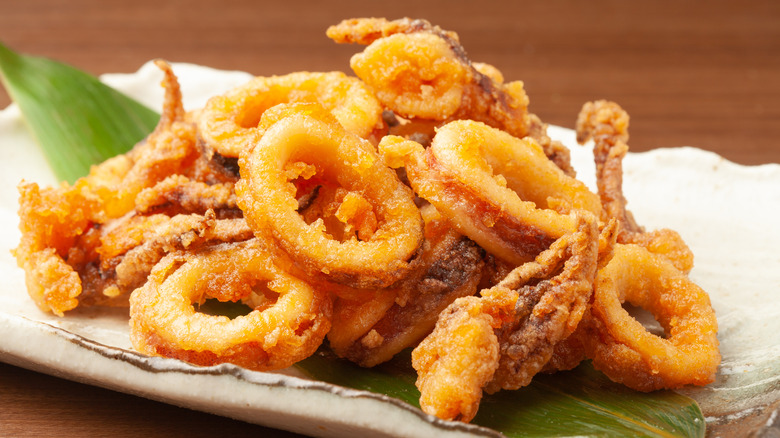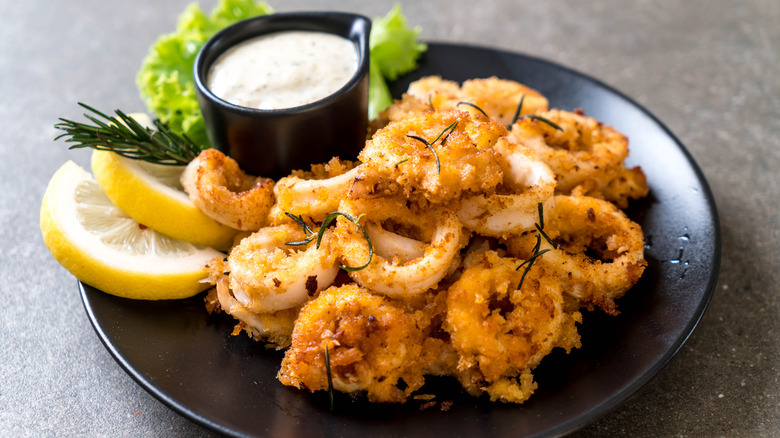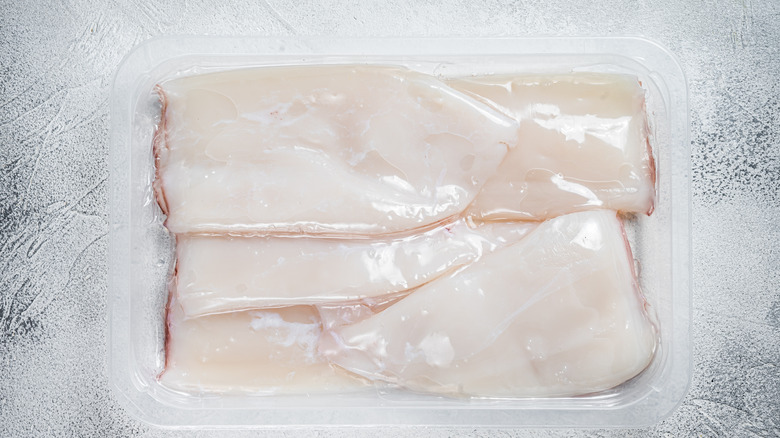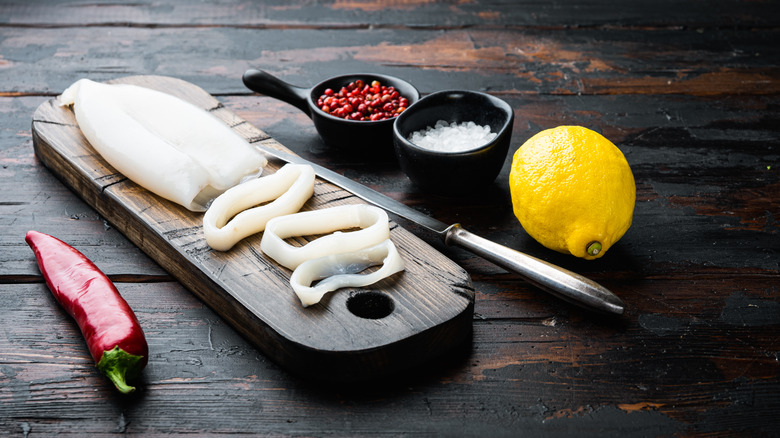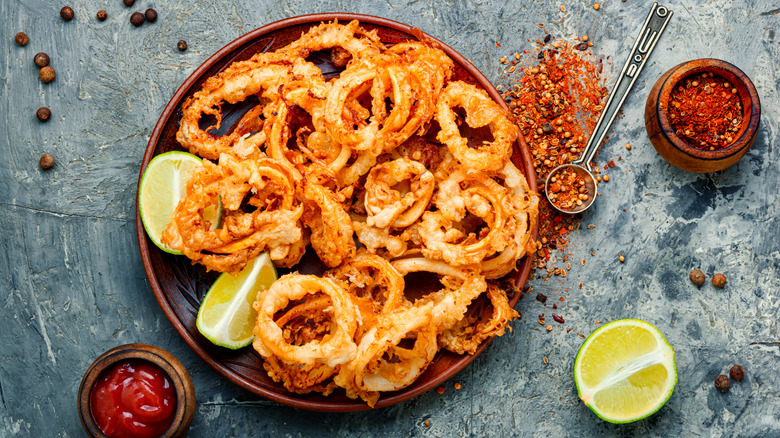What Is Calamari And How Do You Eat It?
When you think of calamari, you may just picture the wildly popular fried appetizer that's a staple at a multitude of restaurants. Some, however, tend to downplay the fact that calamari is not just a crispy fried morsel that is easily shared and fun to eat — it is squid. Some fish-averse people like to conveniently avoid that, but many others find that calamari is absolutely delicious, and it should be celebrated for exactly what it is.
As The Spruce Eats notes, calamari literally means "squid" in Italian. It is commonly served in Spain, China, Portugal, Greece, Taiwan, and many other Asian and Mediterranean countries. A squid is a mollusk, a cephalopod, related to octopus and cuttlefish. Like the octopus, squid have "ink" that they can release when threatened, to cloud the water and enable escape. The Monterey Bay Aquarium also states that eating calamari is a "good alternative" seafood choice from a sustainability perspective (via NPR).
The Spruce Eats also notes that there are "more than 300 species of squid" today. Most squid sold for culinary purposes are about 12 inches or less, but there are squid currently in the oceans who may be up to 80 feet: both colossal and giant squid exist, but can be very elusive...
How is calamari eaten?
While many know only the deep-fried variation, calamari is wonderful no matter how it's cooked — and it can even be enjoyed raw. The flesh is white, mild, and firm. Calamari is sold in regular supermarkets, or you can purchase from a specialty fishmonger. It also freezes well. According to George Mahe of St. Louis Magazine, the body of the squid is called the mantle. The most common calamari preparation is thinly sliced and fried pieces of mantle, but the tentacles are sometimes included as well. This fried method is technically called "calamari fritti."
Calamari's flavor is mild and versatile, often taking on the flavors that it's cooked with. Some other popular uses for squid are in dishes like cioppino, jjampong, ika sansai, ceviche, and yakimono, according to MasterClass. As noted, in most Italian-American preparations, it's served deep fried with marinara sauce, but in many Italian preparations, it's lightly breaded, fried, and served with aioli. Many preparations in Vietnam, China, or Japan, however, are served with hot chilies or even fruit, such an orange sauce, Food Network notes.
It doesn't have to be fried — braised calamari is essentially tenderized, then toughened up and re-relaxed, resulting in a super-tender protein. It's also delicious in seafood salads. AllRecipes notes that calamares en su tinta is made from calamari cooked in its own ink, almost an ink-confit of sorts — delicious and unique! Many also use squid ink to flavor pasta dishes, both in the dough itself or in the sauce.
How to prepare calamari
If you're making calamari at home, be mindful of properly cleaning and preparing it. The cleaning process, NPR explains, involves removing the sac and innards, squeezing off the bony "beak," removing the head, peeling extra skin, and taking out thin bones. While it may sound like a bit of a challenge, we bet you'll be surprised at how simple the process really is. Of course, if you're squeamish about dealing with the squid itself, or you don't have the time, you can always feel free to ask your fishmonger to handle it for you.
Interestingly enough, all squids have 3 hearts. Another fascinating squid fun fact is that their esophagus passes through their brain. Mental Floss notes that improperly digested food can "rub against the brain and cause damage," which might be hard to wrap your mind around — pun intended!
Like most seafood, calamari also boasts some health benefits, mainly protein, zinc, selenium, and vitamin B12 (via Fed and Fit). Food Network also states that squid is a great source of copper and vitamin C. Of course, fried calamari is obviously not the healthiest option, but other, non-fried squid dishes can be great, health-conscious meals.
How do you cook calamari?
In addition to the customary fried calamari, squid is usually cooked using high heat methods, like grilling or broiling. The tentacles are edible but the 'rings' most associated with fried calamari are actually slices of the body. The flavor can be nutty and is often mild, with a texture that is quite firm, according to The Spruce Eats. Be careful not to overcook — overdone calamari can get very chewy and unpleasant to eat.
It can also be eaten raw, stuffed, roasted, or served in soups or stews, according to SF Gate. Calamari can be temperamental; it either requires a fast quick cook time (such as 2-3 minutes), or a full-length braise. You certainly don't need to braise squid for hours like you might beef, though — NPR's braised stuffed squid recipe only requires 40 minutes or so. Squid is often included in dishes like risotto, paella, and various pasta and soups, The Spruce Eats notes, and is commonly grilled and served whole at food stalls in countries like China and Taiwan.
NPR notes that in Italy, baby calamari is often served, and some calamari-laden pasta dishes are also infused with the ink of the squid. Stuffed and braised calamari is amazing, squid-forward soups and stews are popular in multiple cultures, and many enjoy calamari as a starring member of seafood salads. Calamari is also often included in the traditional Italian Christmas Eve dinner known as the Feast of the Seven Fishes.
What is the Fried Calamari Index?
According to The New York Times, their first print mention of fried calamari was in the mid-1970s. The Town Dock notes that after this mention, calamari began to spread — first throughout fine dining restaurants in the '80s, and then in more casual establishments. By the mid-'90s, calamari was almost being enjoyed at a majority of restaurants. In 2014, The New York Times began to trace food mentions in their articles — the same year calamari became Rhode Island's Official State Appetizer, per The Town Dock — which helped to give a clear indication of the food's prominence during a certain era.
This particular trend was called the "Fried Calamari Index," noting how it wasn't mentioned whatsoever prior to 1975 and then boomed in popularity ever since, according to First We Feast. This has become a tangible and quantifiable means of tracking and tracing food trends over time. The index even used SCUs, or standard calamari units, to measure the popularity of various ingredients, dishes, and recipes.
Of course, this index isn't foolproof. Calamari mentions may have decreased since 1996, but that doesn't mean it's any less popular or being served less in restaurants; it's just being discussed in print (or online) less than it was back when it was a novel dish that got people talking.
